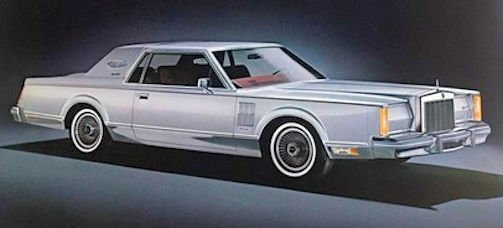Lincoln Continental Mark VI
 |
|
|
Manufacturer |
Lincoln (Ford) |
|
Model years |
1980 to 1983 |
|
Class |
luxury car |
|
Body style |
2-4 door sedan |
|
Layout |
FR layout |
|
Engine |
302 cu in (4.9 L) 5.0L V8 |
|
Transmission |
4-speed AOD automatic |
|
Wheelbase |
2-door: 114.4 in (2,910 mm) |
|
Length |
2-door: 216.0 in (5,490 mm) |
|
Width |
78.1 in (1,980 mm) |
|
Height |
2-door: 55.1 in (1,400 mm) |
|
Curb weight |
3,892–4,219 lb (1,765–1,914 kg) |
The Continental Mark VI is a premium-class vehicle produced by the American automaker Ford Motor Company from 1980 to 1983 and distributed through the Lincoln-Mercury division. It was the fourth generation of a 1968 founded with the Continental Mark III series of luxury models, which is referred to as Mark Series and which was positioned above the Lincoln models. The Mark VI was the only model of the Mark Series, which was offered not only as a coupe, but also as a sedan. He was technically closely related to the contemporary Lincoln Continental and distinguished from him by smaller body showers and a significantly upgraded equipment.
As a result of the Second Oil Crisis, the Ford Motor Company and its competitors were forced to make their models more economical in the future. H. especially to reduce dimensions and weight. Lincoln's standard models, the Lincoln Continental Sedan and the Lincoln Continental Coupe, completed this step as the last models of the "full-size class" in late 1979. They were based on the introduced in model year 1978 Panther platform of the Ford Group, previously for the smaller models Ford LTD and Mercury Marquis had been used.
In the same time required redesign of the Mark model offered - unlike the previous series - a resort to the technology of the Ford Thunderbird not: The Thunderbird the Box Bird generation had been redesigned for model year 1980 in turn, and now took advantage of the so-called Fox platform of the Ford Fairmont. As a result of this downsizing of the Thunderbird was only 5 feet long and belonged to American standards already in the compact class Despite the required downsizing, larger external dimensions were required to prove the superiority of the Mark models. Therefore, the Mark VI as well as the contemporary Lincoln Continental was built on the current Panther platform. Through this conceptual approach, the Mark VI has a special status in the history of the series; later series did not resume this conceptual approach. The decision to offer the Mark VI as a coupé and as a sedan was also unique.
By resorting to the Panther platform Mark VI was much smaller than its predecessor. Compared to the Mark V, the length shortened by 450 mm; At the same time, the new models were up to 400 kg lighter.
In terms of design, the Mark VI was identical to the Lincoln Continental. Both models shared not only the technology, but also most of the body parts. A major difference, however, existed in the wheelbase of the coupe: While the Mark VI Coupe was based on a compared to the Mark VI four-door by 76 mm shorter wheelbase, which corresponded to the two-door versions of the Ford LTD built that (only in small quantities sold) Lincoln Continental coupe on the longer wheelbase of the sedan.
Externally, the Mark VI and the Lincoln Continental differed mainly by the design of the front end; There were also other, mostly in the field of cosmetics lying styling differences. While the Continental used two open double headlamps, the Mark VI round headlamps were hidden behind a body-coloured metal cover. In addition, the radiator grille of the Mark VI was slightly different. Another distinguishing feature of the Mark VI was stylized, d. H. non-functional vents in the front fenders. The roof section of the Mark VI was usually covered with vinyl and designed in the style of a convertible roof; some versions had an oval, Opera Window called window in the C-pillar. Finally, this version of the Mark VI used a stylized spare wheel cover on the trunk lid.
As a drive source, the Mark VI continued to use V8 engines, but the displacement was significantly reduced compared to the previous models. Initially, eight-cylinder engines with 4.9 or 5.8 litres were available; the range of services ranged from and 131 to 142 hp. From the model year 1981 accounted for the larger engine; at the same time the performance of the 4.9-liter engine rose to 147 hp. The power transmission was by a new four-speed automatic, which was basically a conventional three-speed automatic, which had been added an extra-long fourth gear with a translation of 0.67: 1.
The Mark VI models were among the most expensive American vehicles. The Mark VI coupe was offered in 1980 in its basic version for $ 16,300 ($ 3,000 more than the technically identical Continental Coupe). Equipped as a Signature Series, the car cost $ 21,900; The models of the Designer Series were even more expensive. By comparison, a Cadillac Fleetwood Brougham Coupe cost $ 15,300 at the same time. The Ford Fairmont, the most successful car of 1980, was offered for about a third of that price.
The Continental Mark VI produced around 134,000 units in four years, of which around 69,000 four-door models. In the domestic market, the Mark VI competed especially with the Cadillac Eldorado, which had been introduced in 1979. This was about 30 cm shorter than the Mark VI and had with his front-wheel drive a more advanced technology. During the joint production period, the Eldorado was more successful than the Mark VI.

Technical
-
model year
Continental Mark VI
Coupe
Sedan
total
1980
38891
1981
18740
17,958
36698
1982
11532
14804
26336
1983
12743
18113
30856
